Integrating Science Tasks and Puzzles in Computer Role Playing Games
Abstract
:1. Introduction
2. Related Work
2.1. Design Principles for Educational Serious Games
2.2. Aspects of Design Related to the Mechanics of the Game and the Game Genre
2.3. Methodologies of Design for Educational Serious Games
2.4. Serious Games in the Context of the Physical Sciences
3. Materials and Methods
3.1. CRPGs Game Genre
3.2. Educational Content Integration
3.3. Supplementary Design Decisions
3.3.1. Levels and Environment Design
3.3.2. User Interface and Game Controls
3.3.3. Aesthetics
4. Results
4.1. Game Development
4.1.1. Game Engine
4.1.2. Development Process
4.2. Usability Test
4.2.1. Usability Test Setting
4.2.2. Sampling
4.2.3. Measures and Data Analysis
4.2.4. Findings
5. Discussion and Conclusions
Supplementary Materials
Author Contributions
Acknowledgments
Conflicts of Interest
Appendix A. Usability Test Questionnaire
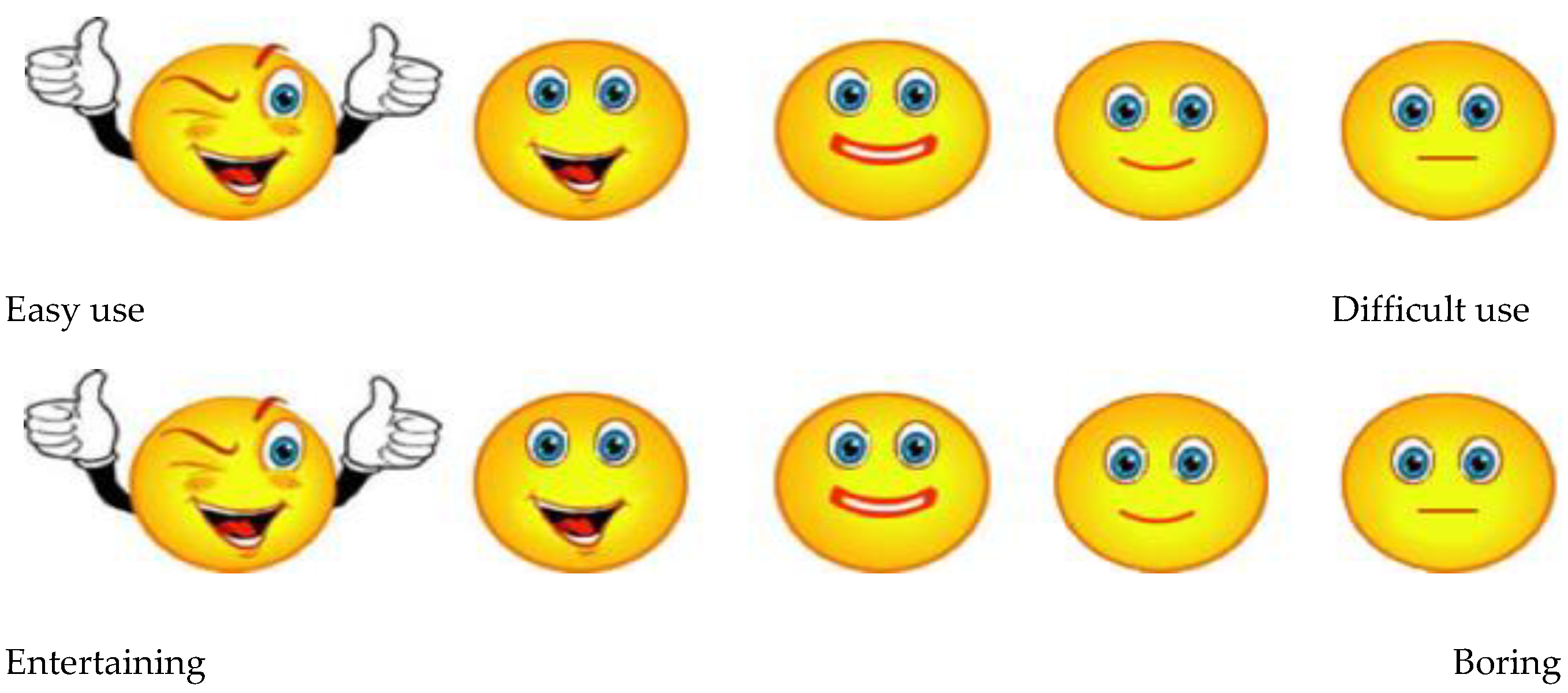
References
- Zyda, M. From visual simulation to virtual reality to games. Computer 2005, 38, 25–32. [Google Scholar] [CrossRef]
- Susi, T.; Johannesson, M.; Backlund, P. Serious Games: An Overview; Institutionen för kommunikation och information: Skövde, Sweden, 2007. [Google Scholar]
- Egenfeldt-Nielsen, S. Beyond Edutainment: Exploring the Educational Potential of Computer Games. Unpublished dissertation, IT University of Copenhagen, Copenhagen, Denmark. Available online: https://www.researchgate.net/publication/245584260_Beyond_Edutainment_Exploring_the_Educational_Potential_of_Computer_Games (accessed on 14 July 2019).
- Dondlinger, M.J. Educational video game design: A review of the literature. J. Appl. Educ. Technol. 2007, 4, 21–31. [Google Scholar]
- Connolly, T.M.; Boyle, E.A.; MacArthur, E.; Hainey, T.; Boyle, J.M. A systematic literature review of empirical evidence on computer games and serious games. Comput. Educ. 2012, 59, 661–686. [Google Scholar] [CrossRef]
- Mayo, M.J. Video games: A route to large-scale STEM education? Science 2009, 323, 79–82. [Google Scholar] [CrossRef] [PubMed]
- Arnab, S.; Lim, T.; Carvalho, M.B.; Bellotti, F.; de Freitas, S.; Louchart, S.; Suttie, N.; Berta, R.; De Gloria, A. Mapping learning and game mechanics for serious games analysis. Br. J. Educ. Technol. 2015, 46, 391–411. [Google Scholar] [CrossRef]
- Ye, Z. Genres as a tool for understanding and analyzing user experience in games. In CHI’04 Extended Abstracts on Human factors in Computing Systems, Vienna, Austria, 24–29 April 2004; ACM: New York, NY, USA, 2004; pp. 773–774. [Google Scholar]
- Wang, H.; Sun, C.T. Game reward systems: Gaming experiences and social meanings. In Proceedings of the DiGRA Conference 2011, Hilversum, The Netherlands, 14–17 September 2011; pp. 1–15. [Google Scholar]
- Chorianopoulos, K.; Giannakos, M.N. Design principles for serious video games in mathematics education: From theory to practice. Int. J. Serious Games 2014, 1, 51–59. [Google Scholar] [CrossRef]
- Gee, J.P. Learning and games. The Ecology of Games: Connecting Youth. Games Learn. 2008, 3, 21–40. [Google Scholar]
- Bopp, M. Storytelling as a motivational tool in digital learning games. In Didactics of Microlearning. Concepts, Discourses and Examples; Waxmann Verlag: Münster, Germany, 2007; pp. 250–266. [Google Scholar]
- Tan, P.H.; Ling, S.W.; Ting, C.Y. Adaptive digital game-based learning framework. In Proceedings of the 2nd International Conference on Digital Interactive Media in Entertainment and Arts, Perth, Australia, 19–21 September 2007; ACM: New York, NY, USA, 2007; pp. 142–146. [Google Scholar]
- Rehak, B. Playing at being: Psychoanalysis and the avatar. In The Video Game Theory Reader; Routledge: Abingdon-on-Thames, UK, 2013; pp. 125–150. [Google Scholar]
- Lim, S.; Reeves, B. Being in the game: Effects of avatar choice and point of view on psychophysiological responses during play. Media Psychol. 2009, 12, 348–370. [Google Scholar] [CrossRef]
- Hirumi, A.; Stapleton, C. Applying pedagogy during game development to enhance game-based learning. In Games: Purpose and Potential in Education; Miller, C., Ed.; Springer: Boston, MA, USA, 2009; pp. 127–162. [Google Scholar]
- Goldstein, J.H. Technology and play. Scholarpedia 2013, 8, 30434. [Google Scholar] [CrossRef]
- Laamarti, F.; Eid, M.; Saddik, A.E. An overview of serious games. Int. J. Comput. Games Technol. 2014, 11. [Google Scholar] [CrossRef]
- Gredler, M.E. Games and simulations and their relationships to learning. Handb. Res. Educ. Commun. Technol. 2004, 2, 571–581. [Google Scholar]
- Wolf, M.J. Genre and the Video Game. The Medium of the Video Game. 2001, pp. 113–134. Available online: https://s3.amazonaws.com/academia.edu.documents/1979904/9h2wevyakguizku.pdf?response-content-disposition=inline%3B%20filename%3DGenre_and_the_Video_Game.pdf&X-Amz-Algorithm=AWS4-HMAC-SHA256&X-Amz-Credential=AKIAIWOWYYGZ2Y53UL3A%2F20190714%2Fus-east-1%2Fs3%2Faws4_request&X-Amz-Date=20190714T140710Z&X-Amz-Expires=3600&X-Amz-SignedHeaders=host&X-Amz-Signature=f8c2c7c8d717dc59b33122166f6d6a33ae96d14d5c67d8bae303d7de978aa8aa (accessed on 1 July 2019).
- Marshall, D.; Coyle, D.; Wilson, S.; Callaghan, M. Games, gameplay, and BCI: The state of the art. IEEE Trans. Comput. Intell. AI Games 2013, 5, 82–99. [Google Scholar] [CrossRef]
- Apperley, T.H. Genre and game studies: Toward a critical approach to video game genres. Simul. Gaming 2006, 37, 6–23. [Google Scholar] [CrossRef]
- Zagal, J.P.; Altizer, R. Examining’RPG elements’: Systems of character progression. In Proceedings of the 9th International Conference on the Foundations of Digital Games, Caribbean, 3–7 April 2014. [Google Scholar]
- Tychsen, A. Role playing games: Comparative analysis across two media platforms. In Proceedings of the 3rd Australasian Conference on Interactive Entertainment, Perth, Australia, 4–6 December 2006; pp. 75–82. [Google Scholar]
- Winn, B.M. The design, play, and experience framework. In Handbook of Research on Effective Electronic Gaming in Education; IGI Global: Hershey, PA, USA, 2009; pp. 1010–1024. [Google Scholar]
- Annaggar, A.; Tiemann, R. Video Game Based Gamification Assessment of Problem-Solving Competence in Chemistry Education. In European Conference on Games Based Learning; Academic Conferences International Limited: England, UK, 2017; pp. 939–943. [Google Scholar]
- Guardiola, E.; Czauderna, A. Merging Gameplay and Learning in Educational Game Design: The Gameplay Loop Methodology in Antura and the Letters. In ECGBL 2018 12th European Conference on Game-Based Learning; Academic Conferences and Publishing Limited: England, UK, 2018; p. 154. [Google Scholar]
- Jiménez-Hernández, E.M.; Oktaba, H.; Piattini, M.; Arceo, F.D.B.; Revillagigedo-Tulais, A.M.; Flores-Zarco, S.V. Methodology to construct educational video games in software engineering. In Proceedings of the 2016 4th International Conference in Software Engineering Research and Innovation (CONISOFT), Puebla, Mexico, 27–29 April 2016; pp. 110–114. [Google Scholar]
- de Lope, R.P.; Arcos, J.R.L.; Medina-Medina, N.; Paderewski, P.; Gutiérrez-Vela, F.L. Design methodology for educational games based on graphical notations: Designing Urano. Entertain. Comput. 2017, 18, 1–14. [Google Scholar] [CrossRef]
- Padilla-Zea, N.; Medina, N.M.; Vela, F.L.G.; Paderewski, P.; Collazos, C.A. PLAGER-VG: Platform for managing educational multiplayer video games. Multimed. Tools Appl. 2018, 77, 2115–2152. [Google Scholar] [CrossRef]
- Aouadi, N.; Pernelle, P.; Marty, J.C.; Carron, T. A model driven architecture MDA approach to facilitate the serious game integration in an e-learning environment. In European Conference on Games Based Learning; Academic Conferences International Limited: England, UK, 2015; p. 15. [Google Scholar]
- Carvalho, M.B.; Bellotti, F.; Berta, R.; De Gloria, A.; Sedano, C.I.; Hauge, J.B.; Hu, J.; Rauterberg, M. An activity theory-based model for serious games analysis and conceptual design. Comput. Educ. 2015, 87, 166–181. [Google Scholar] [CrossRef]
- Short, D. Teaching scientific concepts using a virtual world—Minecraft. Teach. Sci. J. Aust. Sci. Teach. Assoc. 2012, 58, 55. [Google Scholar]
- San Chee, Y.; Tan, K.C.D.; Tan, E.M.; Jan, M. Learning chemistry performatively: Epistemological and pedagogical bases of design-for-learning with computer and video games. In Issues and Challenges in Science Education Research; Springer: Dordrecht, The Netherlands, 2012; pp. 245–262. [Google Scholar]
- Garzotto, F. Investigating the educational effectiveness of multiplayer online games for children. In Proceedings of the 6th international conference on Interaction design and children, Aalborg, Denmark, 6–8 June 2007; pp. 29–36. [Google Scholar]
- Lago, B.L. Al-Kimia: How to Create a Video Game to Help High School Students Enjoy Chemistry. In Serious Games and Edutainment Applications; Springer: Cham, Switzerland, 2017; pp. 259–272. [Google Scholar]
- Ahmad, W.F.W.; Rahman, N.F.A. AKAMIA: Chemistry mobile game-based tutorial. In Proceedings of the 3rd International Conference on User Science and Engineering (i-USEr), Shah Alam, Malaysia, 2–5 September 2014; pp. 221–226. [Google Scholar]
- Craciun, D. Role-playing as a creative method in science education. J. Sci. Arts 2010, 10, 175. [Google Scholar]
- Lucas, J.; Escapa García, M.; González-Eguino, M. The Use of Role-Play Games in Teaching: The International Climate Negotiation Game 2016. Available online: https://addi.ehu.es/handle/10810/17892 (accessed on 21 April 2019).
- Perez, D. Beginning RPG Maker VX Ace; Apress: New York, NY, USA, 2014. [Google Scholar]
- Apostalakis, E.; Panagopoulou, E.; Savas, S.; Tsagliotis, N.; Makri, B.; Pantazis, G.; Petrea, K.; Sotiriou, S.; Tolias, B.; Tsagogeorga, A. Physical Sciences. Ministry of Education, Research and Religion; Organization of Teaching Books. Available online: http://ebooks.edu.gr/modules/ebook/show.php/DSDIM-E107/154/1099,4022/ (accessed on 10 June 2019).
- Bostan, B. Requirements analysis of presence: Insights from a RPG game. Comput. Entertain. (CIE) 2009, 7, 9. [Google Scholar] [CrossRef]
- Folmer, E. Usability patterns in games. Future Play 2006, 6, 21. [Google Scholar]
- Hanna, L.; Risden, K.; Alexander, K. Guidelines for usability testing with children. Interactions 1997, 4, 9–14. [Google Scholar] [CrossRef]
- Hall, L.; Hume, C.; Tazzyman, S. Five degrees of happiness: Effective smiley face likert scales for evaluating with children. In Proceedings of the 15th International Conference on Interaction Design and Children, Manchester, UK, 21–24 June 2016; pp. 311–321. [Google Scholar]
- Salen, K.; Tekinbaş, K.S.; Zimmerman, E. Rules of Play: Game Design Fundamentals; MIT Press: Cambridge, MA, USA, 2004; Available online: https://books.google.gr/books?hl=el&lr=&id=UM-xyczrZuQC&oi=fnd&pg=PP13&dq=game-play+definition&ots=2BHJu_cBVs&sig=Uzppgm_wmTXUY62_tDq_-BiLaGE&redir_esc=y#v=onepage&q=game-play%20definition&f=false (accessed on 9 May 2019).
- Joorabchi, M.E.; El-Nasr, M.S. Measuring the impact of knowledge gained from playing FPS and RPG games on gameplay performance. In International Conference on Entertainment Computing; Springer: Berlin/Heidelberg, Germany, 2011; pp. 300–306. [Google Scholar]
- Campbell, J. The Hero’s Journey: Joseph Campbell on His Life and Work; New World Library: Novato, CA, USA, 2003; Volume 7. [Google Scholar]
- Amory, A.; Naicker, K.; Vincent, J.; Adams, C. The use of computer games as an educational tool: Identification of appropriate game types and game elements. Br. J. Educ. Technol. 1999, 30, 311–321. [Google Scholar] [CrossRef]
- Egenfeldt-Nielsen, S. Third generation educational use of computer games. J. Educ. Multimed. Hypermedia 2007, 16, 263–281. [Google Scholar]
- Gee, J.P. What video games have to teach us about learning and literacy. Comput. Entertain. (CIE) 2003, 1, 20. [Google Scholar] [CrossRef]
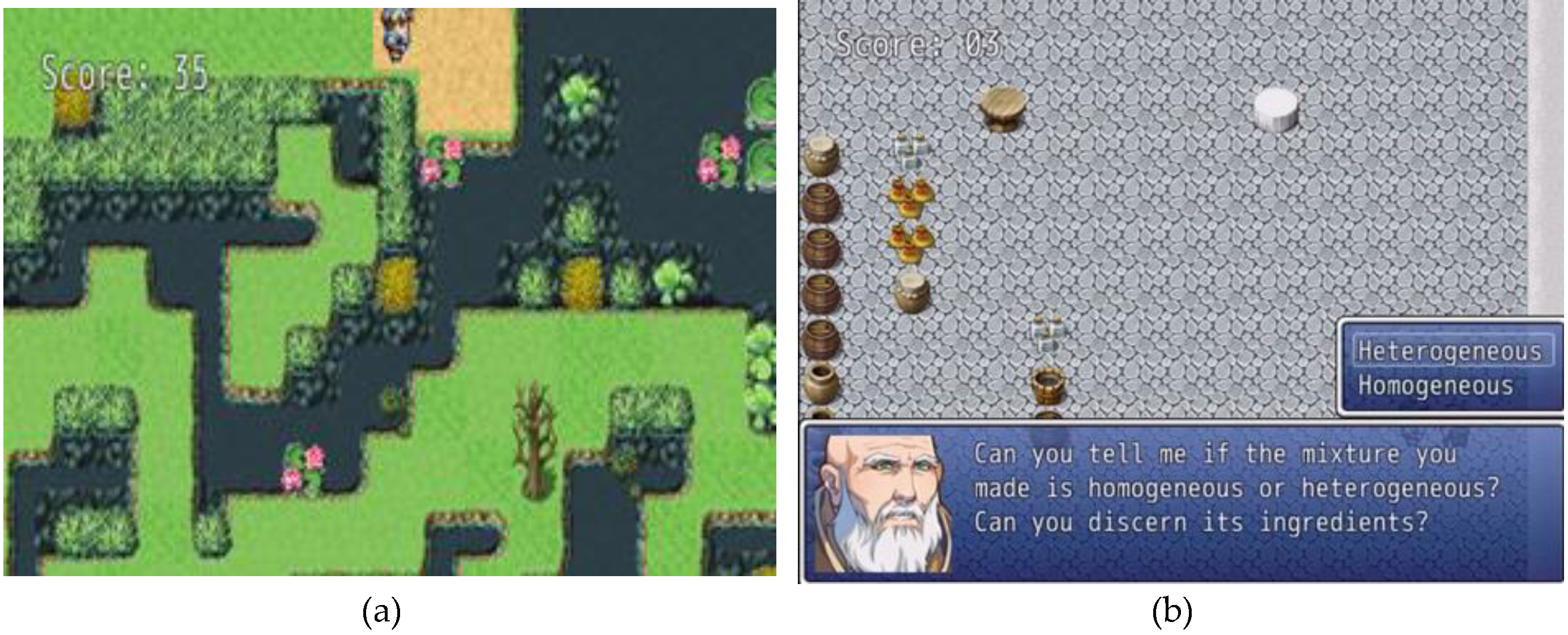
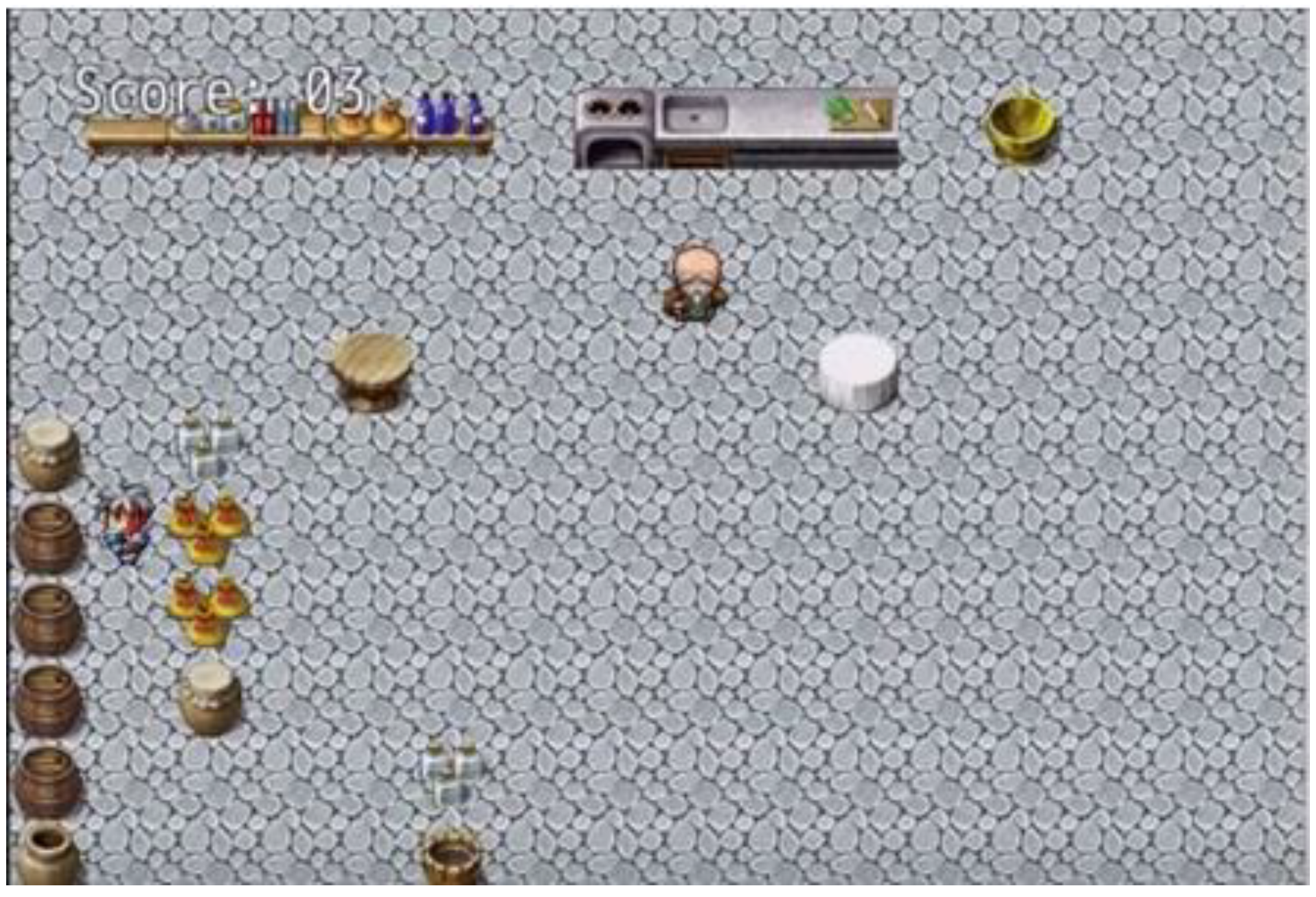
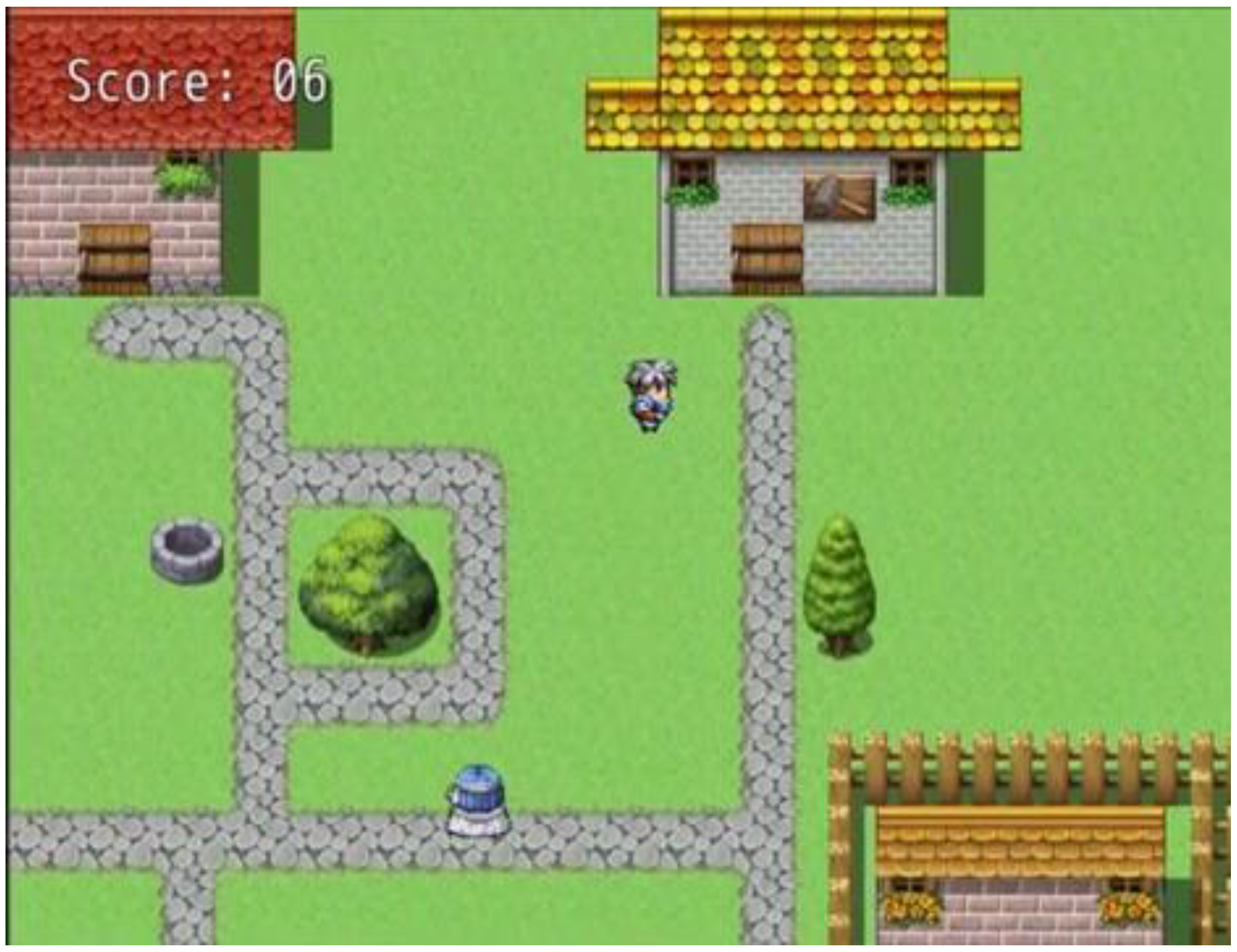
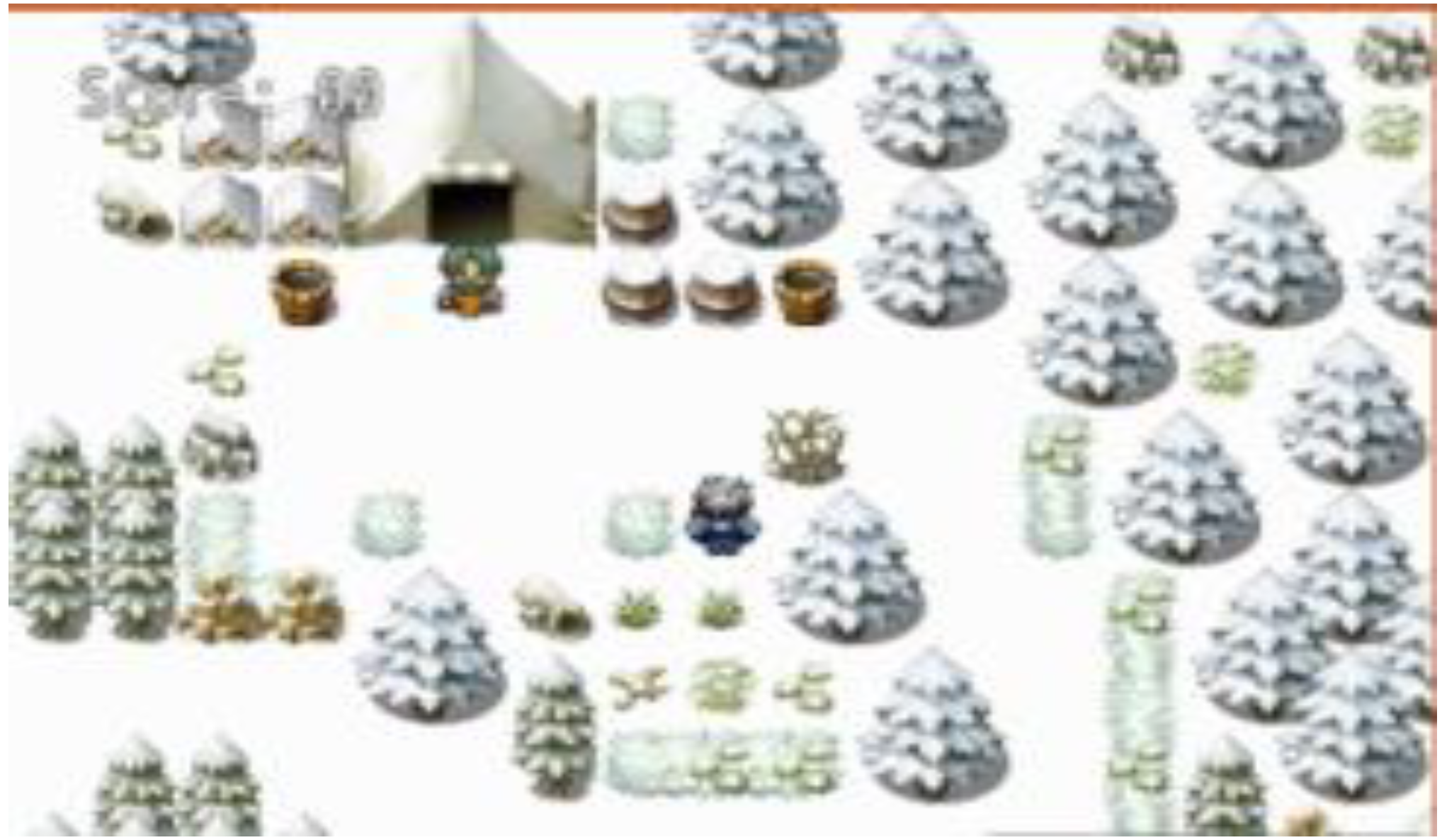
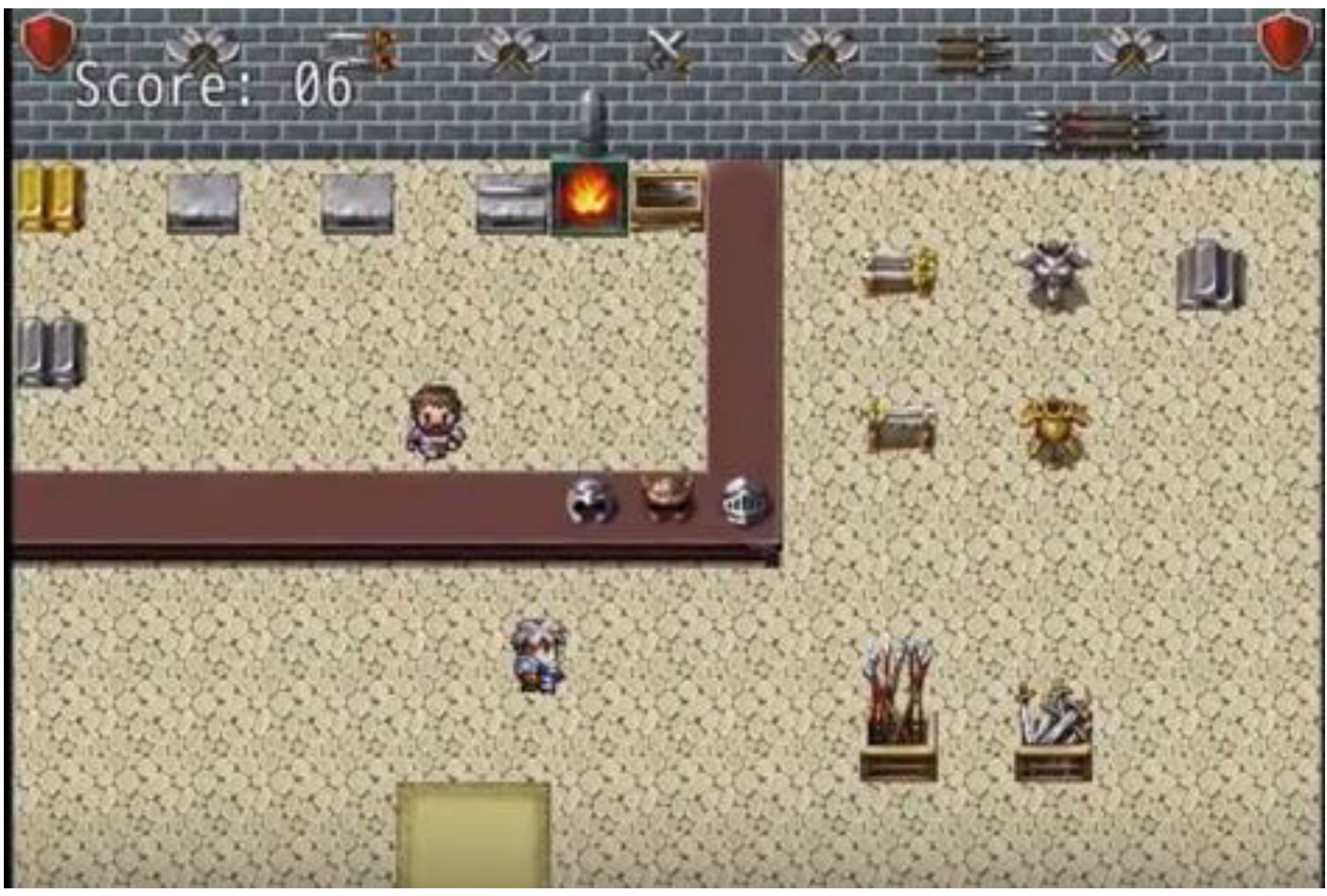

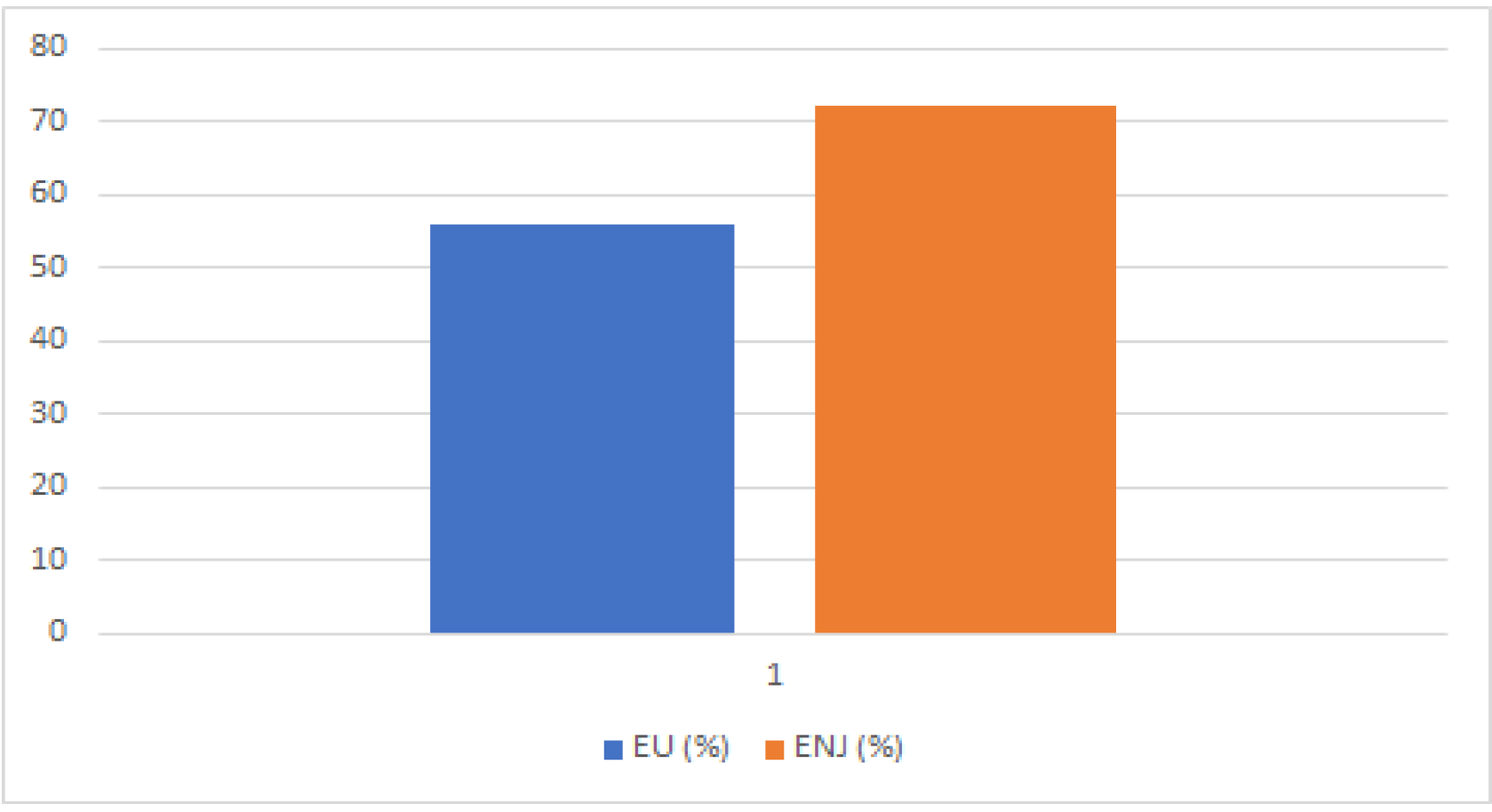
| Game’s Name | Educational Goal | Game Genre 1 | Storyline with Conflict | Source |
|---|---|---|---|---|
| Al-Kimia 2 | Attitudes towards chemistry | CRPG + Action + Adventure | √ | [36] |
| AKAMIA 3 | Learning chemistry | Adventure + Action + Strategy | [37] | |
| Alchemist 4 | Assessment tool | Not defined | [26] |
| Activity | Subject | Description |
|---|---|---|
| Gaming | Students, 11 years old | The player is assigned the task to find and repair the sword which could defeat the evil dragon and bring peace again to the kingdom and its citizens. For achieving the final goal, the player moves in the game world performing tasks, solving puzzles, and acquiring knowledge and experience to prove his skills. |
| Learning | Students, 11 years old | The player needs to understand and practice the concepts of mixtures; homogeneous/heterogeneous mixtures; temperature; heat; the use of a thermometer; evaporation and boiling; foundries; chemical composition of water; molecules types, such as solids, liquids, and gas; melting points of various metals; salt pans; and the metal alloy making process within the foundry. |
| Intrinsic instruction | Game mechanics which guide players | The digital CRPG assists players through various mechanics, such as rewards and tips to achieve a better understanding of certain science concepts, according to the curriculum of the corresponding book. |
| Extrinsic instruction | Science teachers | The game will be used as a supplement by science teachers to assist in the learning process of science concepts. |
| Sequence Node | Gaming | Learning | Intrinsic Instruction |
|---|---|---|---|
| Storytelling | Purpose of the game | - | - |
| 1st task | VC explores the lab in order to find 3 mixtures | Mixtures | NPC introduces curriculum, assigns the task, and guides with feedback |
| 2nd task | VC prepares his own mixture, looking for the appropriate materials in the lab | Mixtures | NPC introduces curriculum, assigns the task and guides, giving feedback |
| 1st puzzle | VC answers a multiple-choice test related to the mixture he prepared | Homogeneous/heterogeneous mixtures | NPC provides a test assignment and feedback |
| 3rd task | VC explores new locations to bring 3 mixtures to the lab | Mixtures | NPCs introduce curriculum, assign tasks, and guide the player with feedback and tips |
| 4th task | VC tries to separate salted water, mud, and metal alloy mixtures in the lab, for the metal alloy separation, he must visit the blacksmith’s shop | Thermometer/evaporation/boiling/heat | VC is guided by the NPC and the game itself through feedback in order to complete the tasks and learn the content |
| 2nd puzzle | VC answers a multiple-choice test | Evaporation/boiling | NPC provides a test assignment and guides the player with a tip to continue the plot |
| 5th task | VC must find sand and fire-wood for the blacksmith, then he must wait for a while | Temperature/heat/global solvent | NPCs introduce curriculum and assign the player with two tasks |
| 3rd puzzle | Meanwhile, another multiple-choice test is provided to the VC | Global solvent/sediment/solution | NPC presents new curriculum and provides a test assignment, feedback is also provided |
| 4th puzzle | The VC is presented with an image that depicts the state of a material’s molecules. Then, he must choose between items that correspond to that image | Molecules types of solid, liquid, and gas, foundries, thermal energy/temperature | NPC provides curriculum and test assignment, they additionally give a tip and feedback |
| 4th puzzle | The VC returns to the blacksmith’s shop and he is presented with more curriculum, then, he must choose the right fire for melting different metals | Melting points of various metals | NPCs provide curriculum, test assignment, feedback, and tips |
| 6th task | The VC visits the frozen mountains to find and bring fire-wood and snow | NPC assigns the VC with the task to visit frozen mountain and bring fire-wood and snow | |
| 5th puzzle | VC visits salt pans, watches the process of salt making, and answers a multiple-choice test | Separation of salt and water through evaporation | NPC introduces curriculum, assigns test, and provides feedback |
| 7th task | VC is re-forging the legendary sword, using the equipment and fire in the blacksmith’s shop | Metal alloy making process within the foundry | NPC guides the player to make the sword |
| 8th task | VC fights with the dragon | - | - |
| Storytelling | End of the game | - | - |
| Coding Categories | Examples |
|---|---|
| Player’s support (students) | “it does not explain the buttons”, “I need more instructions”, “instructions are tiresome”, “I did not know what to do next” |
| Use for learning (students) | “good idea”, “good way of learning”, “I don’t think I can learn this way” |
| Entertainment suggestions (students) | “more action”, “more random events” |
| Game content integration (teacher) | “better processes representation”, “not answers yes or no” |
© 2019 by the authors. Licensee MDPI, Basel, Switzerland. This article is an open access article distributed under the terms and conditions of the Creative Commons Attribution (CC BY) license (http://creativecommons.org/licenses/by/4.0/).
Share and Cite
Garneli, V.; Patiniotis, K.; Chorianopoulos, K. Integrating Science Tasks and Puzzles in Computer Role Playing Games. Multimodal Technol. Interact. 2019, 3, 55. https://doi.org/10.3390/mti3030055
Garneli V, Patiniotis K, Chorianopoulos K. Integrating Science Tasks and Puzzles in Computer Role Playing Games. Multimodal Technologies and Interaction. 2019; 3(3):55. https://doi.org/10.3390/mti3030055
Chicago/Turabian StyleGarneli, Varvara, Konstantinos Patiniotis, and Konstantinos Chorianopoulos. 2019. "Integrating Science Tasks and Puzzles in Computer Role Playing Games" Multimodal Technologies and Interaction 3, no. 3: 55. https://doi.org/10.3390/mti3030055
APA StyleGarneli, V., Patiniotis, K., & Chorianopoulos, K. (2019). Integrating Science Tasks and Puzzles in Computer Role Playing Games. Multimodal Technologies and Interaction, 3(3), 55. https://doi.org/10.3390/mti3030055






